by Art Merrill | Contributing Editor
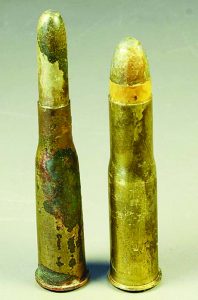
Two mystery cartridges from the age of transition.
When people learn that we’re handloaders they expect us to know stuff. OK, fair, enough – our hands-on experiences combined with our internal database and knowledge of where and how to find information mean we’ve probably got a firmer handle on the ins and outs of cartridges than do most shooters who don’t handload. So, if you’re a handloader, you can expect folks to bring you some extracurricular homework now and then.
One life lesson I employ almost daily is that nobody knows everything about anything, so learning never stops. Applying that here, at the February Washington’s Birthday Match, a popular annual fundraiser to send our Arizona Highpower Juniors to compete at Camp Perry, a fellow shooter handed me a sandwich bag of old cartridges and asked me to identify them.
I stood there in the cold mud and peered through the distortion of rain drops on the clear plastic bag and mentally scratched my head. Five big bottleneck rimmed cartridges with paper patched lead bullets, all lined up in an angled charger. A sixth different cartridge, smaller, also rimmed bottleneck, topped with a round nosed FMJ bullet of indeterminate material.
“Well, uh, the large ones look kinda like .43 Mauser and the other one like, maybe, 8mm Lebel,” I said, “but it’s hard to tell. I’d have to measure them and do a little research to be sure.” And just like that: homework assignment!
Classify, measure, compare
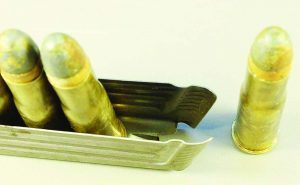
A charger for black powder cartridges?
The charger by itself is an elegant bit of work. Made of stamped metal, one end has a rounded opening to readily accept the wide rim of the fat cartridge; after dropping them into the opening each cartridge slides easily into place toward the opposite end. Stamped ridges hold rims to prevent cartridges from falling out. More durable than merely “adequate,” the charger is as interesting and as representative of its day as the cartridges themselves. The charger, surprisingly, became the central learning point in this adventure.
I’d already done the first step in cartridge ID while standing in the oxymoronic desert rain, a visual assessment of physical characteristics: large, rimmed, bottleneck, paper patch, lead bullet. Obviously black powder cartridges, and military, if the charger is, indeed, intended for them. The lone cartridge has all the earmarks of an early smokeless type: rimmed, steeply tapered, round nose FMJ bullet.
Deciphering old, foreign headstamps is pretty much an arcane skill of the expert, but sometimes the markings can render us a clue. The black powder cartridge headstamp includes an “18” and an “87” which we can surmise is an 1887 manufacture date. Also present is the Roman numeral “VI” and what appears to be an attempt at a Continental-type stylized eagle. Corrosion on the smokeless cartridge case head obscures all but a “1929” stamp. The black powder case has a feature not unusual but also not universal in its day, a raised portion in the center of the case head. This will also aid us in identification.
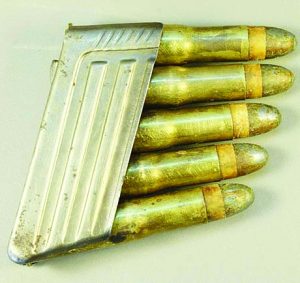
The old charger design is quite elegant in its functionality.
The visual gets us in the “obsolete military, late black powder era, European” and “obsolete military, early smokeless, probably European” ballparks; now to take some swings with a caliper to round the bases and get to home plate. The basic measurements we need without disassembling the ammunition are cartridge overall length (COL), case length, bullet diameter, neck diameter and rim diameter. We’ll measure bullet diameter at the widest possible point; for the smokeless case this is easily done right at the case mouth. The other cartridge’s paper patching means we’ll have to measure the patch as well as the bullet diameter. Especially with obsolete black powder cartridges manufactured when tolerances weren’t as tightly held as today, and especially with paper patched bullets being undersize and patches impossible to make uniform within a few thousandths of an inch, cartridge dimensions aren’t going to be precise – hence measuring as many samples as possible and working from averages.
We then compare our averaged results to a careful perusal of the Ammo Encyclopedia (Michael Brussard, Blue Book Publications), and cross reference to another very useful publication, John J. Donnely’s Handloader’s Manual of Cartridge Conversions, (Stoeger Publishing Company) and decide they most closely match the 11.15x58Rmm Austrian Werndl M77 black powder cartridge. Applying the same to the smokeless cartridge leads us to conclude it is the 8x60Rmm Portuguese Guedes. The latter is reinforced by a bit of decomposing cardboard packaging accompanying the smokeless cartridge that an online translator identifies as Portuguese reading, “10 Cartridges for Rifle 8m/m.” This is consistent with Portuguese Kropatschek/Steyr-Kropatschek rifles chambering that cartridge. We’re done with that one.
A single-shot charger?
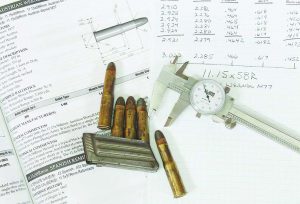
The logical approach works best to ID old cartridges.
OK, we’re confident we’re looking at the 11.15x58Rmm Austrian Werndl M77 cartridge, but what about that charger? The cartridge’s home from 1877 to 1886 was the Werndl Model 1877 rifle (hence the name), when newfangled smokeless powder in the comparatively svelte 8x50Rmm Austrian Mannlicher cartridge relegated the fat, old 11.15x58R to obsolescence. The (assumed) 1887 manufacture date of the headstamp is a reasonable expectation that the old cartridges were still being made for the many rifles still on hand during transition to the new cartridge and rifle.
But the Werndl Model 1877 was a single-shot with a Snider-type breech so a charger for it makes no sense. The charger was clearly made specifically for the cartridge, so there must have been a magazine-fed bolt action rifle made for the 11.15x58R AFTER it was already superseded by the 8x50R, as unlikely as that sounds.
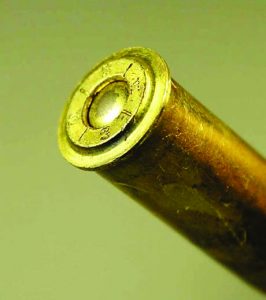
The 11.15x58Rmm case head design is unseen today.
The concurrent military transition from black to smokeless powder and from single shot to repeating rifles is as convoluted as it was rapid, much of that driven by the political shenanigans in Europe. Nations were trying to make the changeover while dealing with internal upheavals as well as with restive, saber-rattling neighbors, with the result that single-shot black powder arms were still in use alongside and against smokeless powder repeaters right into WWI. Herein lies the answer. Austria’s Model 1886 Mannlicher infantry rifle, a bolt action box magazine repeater, replaced the Werndl in 1886 but still chambered the old black powder cartridge, with rifles in smokeless 8x50R not being produced in number for another two years. The charger is for the Mannlicher Model 1886 rifle that utilized the obsolete cartridge for a mere two years.
Mini-mystery solved, and a new bit of obscure information added to the databank. I called the shooter, offered him my opinion on the cartridges and said I’d return them to him at the next match. After thanking me he asked, “Do they have any value?”
“I have no idea,” I said. “I didn’t look into that, all I did was ID them.”
“Oh. OK,” he replied. “I’ve got more; you can have those.”
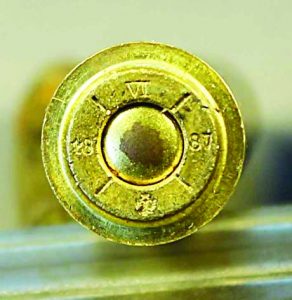
Headstamps generally offer clues rather than absolute ID.
Payment enough for a few hours of research, I suppose, though I still don’t know and don’t really care if the cartridges and charger have monetary value. I value them as history in my hands, a link to shooters and soldiers, firearms and cartridge designers of those fascinating days of change. Understanding these relics is to understand something about their world, and we can’t understand where we are and reasonably predict where we may be headed unless we first understand where we’ve come from.



